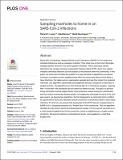Sampling manholes to home in on SARS-CoV-2 infections
Author(s)
Larson, Richard Charles; Berman, Oded; Nourinejad, Mehdi
Downloadjournal.pone.0240007.pdf (3.300Mb)
Publisher with Creative Commons License
Publisher with Creative Commons License
Creative Commons Attribution
Terms of use
Metadata
Show full item recordAbstract
About 50% of individuals infected with the novel Coronavirus (SARS-CoV-2) suffer from intestinal infection as well as respiratory infection. They shed virus in their stool. Municipal sewage systems carry the virus and its genetic remnants. These viral traces can be detected in the sewage entering a wastewater treatment plant (WTP). Such virus signals indicate community infections but not locations of the infection within the community. In this paper, we frame and formulate the problem in a way that leads to algorithmic procedures homing in on locations and/or neighborhoods within the community that are most likely to have infections. Our data source is wastewater sampled and real-time tested from selected manholes. Our algorithms dynamically and adaptively develop a sequence of manholes to sample and test. The algorithms are often finished after 5 to 10 manhole samples, meaning that—in the field—the procedure can be carried out within one day. The goal is to provide timely information that will support faster more productive human testing for viral infection and thus reduce community disease spread. Leveraging the tree graph structure of the sewage system, we develop two algorithms, the first designed for a community that is certified at a given time to have zero infections and the second for a community known to have many infections. For the first, we assume that wastewater at the WTP has just revealed traces of SARS-CoV-2, indicating existence of a “Patient Zero” in the community. This first algorithm identifies the city block in which the infected person resides. For the second, we home in on a most infected neighborhood of the community, where a neighborhood is usually several city blocks. We present extensive computational results, some applied to a small New England city.
Date issued
2020-10Department
Massachusetts Institute of Technology. Institute for Data, Systems, and SocietyJournal
PLoS ONE
Publisher
Public Library of Science (PLoS)
Citation
Larson, Richard C. et al. "Sampling manholes to home in on SARS-CoV-2 infections." PLoS ONE 15, 10 (October 2020): e0240007 © 2020 Larson et al.
Version: Final published version
ISSN
1932-6203